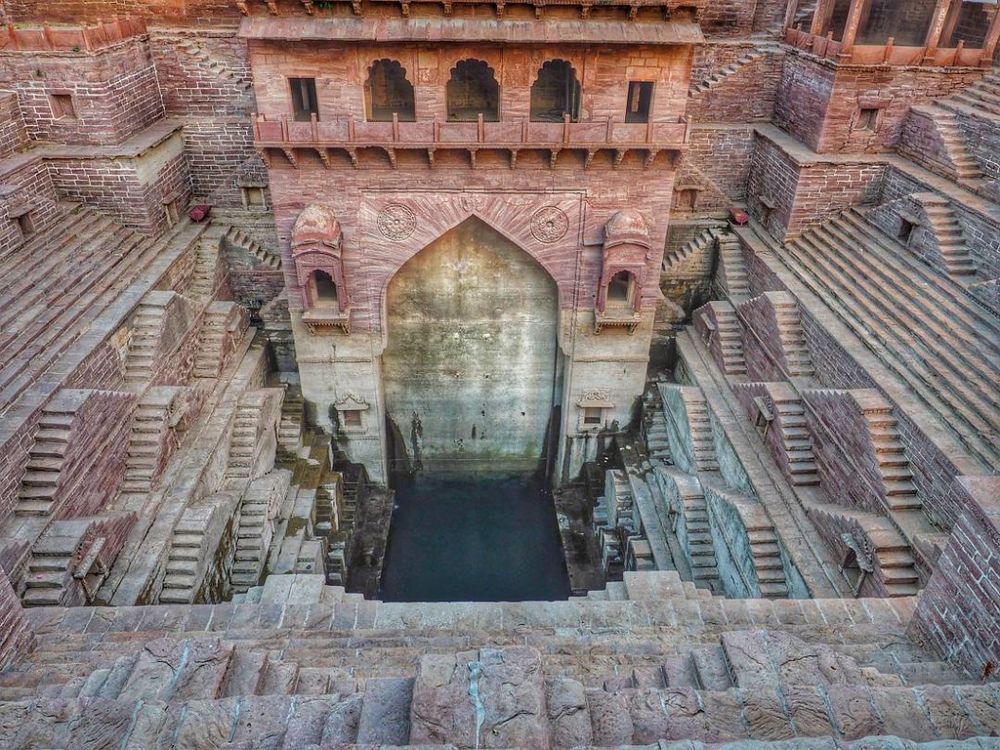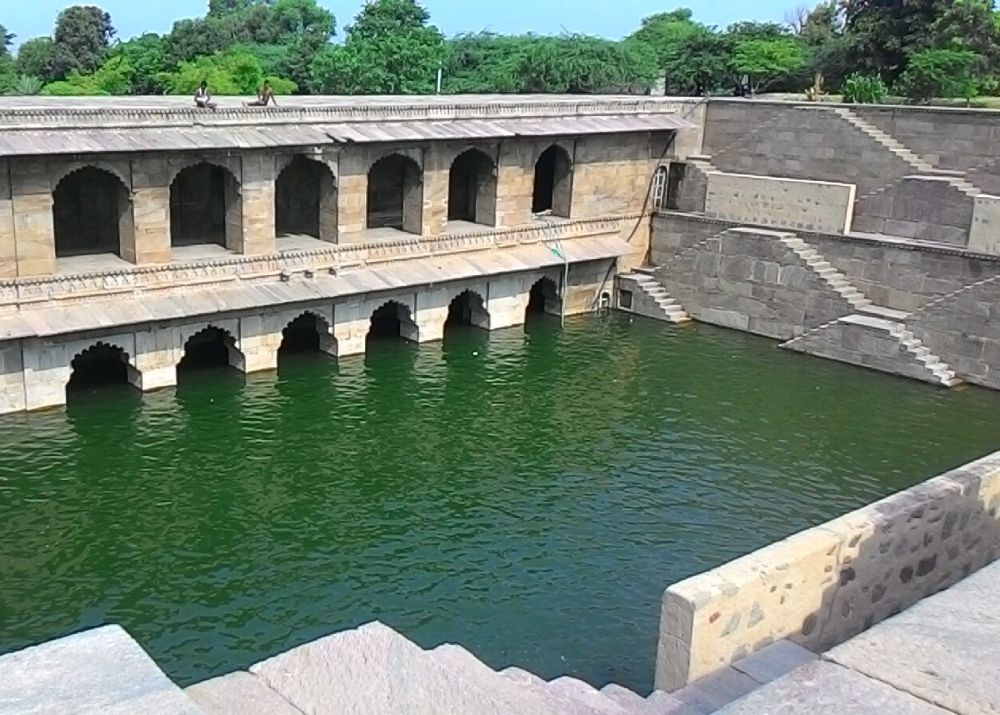On a trip through North India, you can admire several stepwells wells, genuine works of engineering and cultural art. These extraordinary wells, of which the most famous is probably the Chand Baori in Abhaneri, are characterised by a series of high steps leading to the deep levels. below. Besides being architecturally impressive structures, they represent an ancient system of water conservation. Visiting these wells offers an immersion into the rich history and culture of Rajasthan.
Table of Contents
Stepwells in India: practical function and architecture
Stepwells, also called baori, vav or baoli, are incredible works of engineering. They are richly decorated with intricate ornamentation, often comparable to Hindu temples. Widespread mainly in northern India, but also in more arid regions as far as Pakistan, they were designed to adapt to the seasons and allow access to water through a series of terraces connected by high steps.
PLAN YOUR TRIP TO INDIA
When in India, stay connected at the best rates by purchasing an Airalo eSIM online before your trip. This eliminates the hassle of purchasing a physical SIM at the airport.
About travel insurance, Heymondo is the way to go. They offer comprehensive coverage against unexpected events like medical emergencies, trip cancellations, lost luggage, and more. Heymondo provides excellent value for money and will give you peace of mind on your travels!
Their function was essentially practical, to ensure the availability of water during periods of drought. In regions of India where there is an abundance of fresh water only during the monsoon season, stepwells could store water until the next rainy season, when rivers, streams and other natural reservoirs dried up.
Some stepwells were connected to sumptuous buildings that served as cool retreats during the summer for noble families. Others included ramps for livestock or offered the local population the opportunity to bathe, wash clothes or draw water for agriculture. The stepwells, through their monumental structure, tell a great deal about the history and culture of India.
Rajasthan’s most beautiful stepwells
Today, you can see ancient stepwells in different areas of India and Pakistan, in different states of preservation. The highest concentration is found in northern India, often far from the beaten tourist paths. Stepped wells represent an ancient technology unique to India, now popular with visitors to Rajasthan.
Originally built primarily to store water, they also served as air-conditioning systems in the summer noble palaces sometimes connected to them. The base of stepwells is in fact 10 degrees cooler than the surrounding areas. This feature offers great relief from the region’s hot weather.
Historians, visitors and travellers alike are fascinated by stepwells because of their incredible architecture. Below is a list of the most spectacular ones you can find in Rajasthan.
Chand Baori, Abhaneri
The famous Chand Baori in Abhaneri, 94 kilometres from Jaipur, is undoubtedly the most famous stepwell in Rajasthan. Named after the Hindu king Raja Chanda, responsible for the construction of the lower levels, the complex has passed through several eras. The oldest portion dates back to the 8th century. Indeed, the Chauhan rulers of the Mughal dynasty, in the 18th century, contributed to the construction and ornamentation of the upper palace, giving it a more Islamic than Hindu feel.
The structure of Chand Baori today looks like a deep square pit with an imposing temple at the back, with 3500 steps running 13 storeys along the sides of the vast central tank. These steps form an intricate cross-shaped pattern that recalls the elegance of the facets of a cut diamond. Also famous in the film world, the Chand Baori stepwell made a brief appearance in the 2012 film The Dark Knight – The Return.
Chand Baori
Abhaneri, Rajasthan 303326, India

Panna Meena Ka Kund, Amer
Located a few kilometres away from the Pink City of Jaipur and on the way to Amber Fort, the stepwell Panna Meena Ka Kund is still a relatively un-touristy destination. Built in the 16th century for the purpose of providing drinking water, irrigating fields and meeting the daily needs of the population during the summer droughts, this stepwell became a social meeting point for the local community. Its deep symmetrical steps descend to eight underground levels, creating a fascinating architectural structure decorated with niches and zigzag motifs.
Panna Meena Ka Kund
Amer, Rajasthan 302028, India

Toorji Ka Jhalra, Jodhpur
Built in 1740 in red sandstone, Toorji Ka Jhalra features intricate decorations of lions, elephants and water spouts. Once frequented by locals to find relief from the summer heat of Jodhpur, as well as a water reservoir. Now it has been recently restored and is definitely worth a visit.
Toorji Ka Jhalra
Makrana Mohalla, Sutharo Ka Bass Rd
Gulab Sagar, Jodhpur, Rajasthan 342001, India

Raniji Ki Baori, Bundi
Built in the year 1699 by Rani Nathavati Ji, Raniji ki Baori is a famous stepwell located in Bundi. It was also used in the past as a meeting place for religious and social purposes. As many as 50 such stepwells were built around the city of Bundi, but no others seem to have survived.
Raniji Ki Baori, Bundi
Bundi Rd, near k. N, Adisal Singh Colony
Gayatri Nagar, Bundi, Rajasthan 323001, India
Hadi Rani Ki Baori, Tonk
Hadi Rani Ki Baori is located in Tonk, 150 km from Jaipur and was built in honour of Hadi Rani, a figure linked to a tragic Rajput legend. This stepwell is very famous in India because it was here that Paheli, a popular Bollywood film released in 2005. Our guide showed us part of this movie about love and ghosts during our visit.
The legend associated with this stepwell is linked to the name of Hadi Rani. She was the wife of the commander-in-chief of the Rajput army Ratan Chundawat. When enemies attacked the region, Ratan Chundawat resisted fighting because he did not want to leave his beloved wife. Hadi Rani convinced her husband to fight, who agreed, but asked his wife for a token of his love to take with him into battle.
Hadi Rani, realising that her husband’s attachment to her was an impediment in fulfilling his duty, sacrificed her own life. She had her head cut off, which was then presented to her husband according to her instructions. Ratan Chundawat was unable to bear the burning pain of his wife’s selfless sacrifice. So, once he repulsed the enemy army by fighting with his wife’s decapitated head tied to his own body, he also had himself decapitated to join his wife in death.
Hadi Rani Ki Baori
Ladpura, Surajpura, Rajasthan 201306, India

Bhooton Ki Baoli, Ransi
The stepwell Bhooton Ki Baoli, located in Ransi, Rajasthan, 90 kilometres from Jodhpur, is surrounded by local legends. Built with such advanced techniques for the time, people could not give a rational explanation. It is said that this well was built by a man named Thakur Jai Singh, who, on a trip to a fair, stopped by a lake. According to the legend, a ghost appeared, asking to quench his thirst because he could not do it himself. In return for Jai Singh’s kindness, the ghost agreed to grant a wish.
Jai Singh asked for the construction of a magnificent palace to beautify his city. The ghost agreed, but on two conditions. First, the construction would be extended 100 times by the ghost, compared to the work done by the labourers hired by Jai Singh. Second, the agreement would have to remain secret. The next day, Jai Singh started work on the well and the day after his men found the stepwell half built.
To satisfy his curiosity, Jai Singh’s wife forced him to reveal the secret, breaking the pact with the ghost. Locals believe that the building was planned to span seven storeys, but remained only two storeys after the ghost stopped the work. The stepwell also remained unfinished with 174 steps and a depth of 60 metres.
Bhooton Ki Baoli
Ransi
Handy tips for exploring Rajasthan’s stepwells
Visiting the stepwells of Rajasthan is a journey through the unique stories each structure tells. The unique architecture of these wells, located in the vicinity of major cities or ancient capitals of Rajasthan, attracts many travellers.
If you are travelling in a group with a driver and a local guide, you can certainly include the most well-known ones in your itinerary. If you prefer to travel independently, hiring a car might seem like an option. Indeed, given India’s chaotic roads and bustling traffic, I recommend an organised tour with a local travel agency, taking care to choose a reliable one.
Some stepwells require an entrance fee, while smaller ones in the towns may be freely accessible. For safety reasons, you are almost never allowed to go down the steps, even to take photos. In fact, you will be immediately stopped by the guards guarding the area. Finally, always bear in mind the scorching climate of Rajasthan and make sure to carry a bottle of water with you at all times.
Visiting the fascinating stepwells of Rajasthan is a journey through the history and unique architecture of the region. Write to me in the comments if you have already visited any of these unique structures or if you have any further useful tips for your visit.
